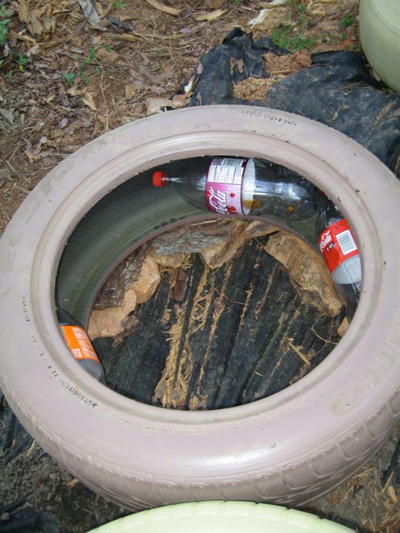DROUGHT A MIXED BLESSING
OK – admit it. You have not seen nearly as many mosquitoes this summer as you did last year. Those bloodsucking creatures must have ample water in which to multiply. With the drought in full swing, the only water in my landscape is the trickle off my forehead while I pull weeds.
By this time last year, I had fielded dozens of complaints about Asian tiger mosquitoes making outdoor life unbearable. By early July this summer I had received nary a one on my radio show.
Ticks, though, seem intent on making up for mosquitoes in the misery index. My kids find them in their beds, brought inside by our cat, “Tick Boy”. My son has found more than one in his hair. In my family, a simple itch now prompts a thorough “tick check” of the affected area, no matter how private the spot of skin might be.
TICKS TO KNOW The American dog tick is the most common tick found locally outdoors. They are easy to identify because the large white spot on their back is so easy to see with the naked eye. This tick feeds on several animals: gray squirrels, chipmunks, possums and even birds. For this reason, it is widely distributed in the out-of-doors. The lone star and black-legged tick might also be found if you live in an area that was once heavily wooded.
If your home has much shrubbery, tall grasses or wooded areas, you probably have ticks somewhere on your property. When it is hungry, a tick climbs to the end of shrubbery branches or to the top of tall grass. A host, whether possum or person passing by, stimulates the tick to cling to hair or clothing and crawl about looking for a place to enjoy a blood meal. The tick will wander, looking for a suitable place, for several hours. Ticks must feed on a host two or three times before becoming adults.
DRESS LIKE A NERD Since the tick crawls for a time on its host, the harder it is to find bare skin, the more chances it will be brushed off. If you can wear long pants outdoors, tuck the pant legs into your socks, so the tick has to climb up the outside of your slacks. Tuck your shirt into your pants to further frustrate the tick into climbing even higher up your clothing. If you prefer to wear shorts and loose clothing, lightly spray your sock tops, waist band and shirt collar with an insect repellent containing DEET (Deep Woods Off, Cutters, etc).
MAKE A TICK DRAG If your children like to play in the yard but you are constantly finding ticks on them, try building a tick drag. Staple one edge of a four foot by three foot piece of white flannel or fleece to a long wooden stick. Drag the flag over your grass and along the edges of trails through the woods. The ticks will be stimulated to cling to the cloth, where they are easy to see, capture and kill. If the drag is too much trouble, be sure to keep your grass mowed frequently and cut down any weedy areas. Prune back the low shrubbery that lines your woodland trails to ensure that walkers don’t brush against the limbs.
If you own a dog or cat, inspect it every few days for ticks on the skin. Look particularly closely behind their ears and between their toes. A flea comb can also be used to comb out the ticks before they settle down to feed. Ask your veterinarian about tick and flea control chemicals for the individual animal. Insecticides such as permethrin (Bonide Eight), esfenvalerate (Ortho Bug-B-Gon) or chlorpyrifos (Dursban) can be sprayed onto tick habitat. There is no advantage to spraying the entire yard; concentrate your efforts where the ticks are most likely to be found.
EEEK! YOU’VE FOUND ONE! Unlike chiggers and mosquitoes, ticks feed with little notice. You might not detect that one has taken up housekeeping until you feel an unaccustomed bump behind your ear or under your waistband. Remove embedded ticks with small tweezers as near to the point of attachment as possible. Use a firm, steady pull. Do not jerk or twist, because you may break off the mouthparts and cause an infection. If you don’t have tweezers, protect your fingers with paper or cloth while you pull.
Apply a disinfectant to the site once the creature is dislodged. It is a good idea to keep the tick in a small bottle of alcohol for a few days. If an infection develops, call your doctor for advice.
While I am sure no creature is present on the earth without reason, I have yet to figure out the higher good served by a tick. If you can imagine an explanation for why ticks exist, e-mail me at the address above and I’ll share your response with other readers.
MORE INFORMATION
Protect Yourself from Ticks http://www.ces.uga.edu/pubcd/L417.htm














